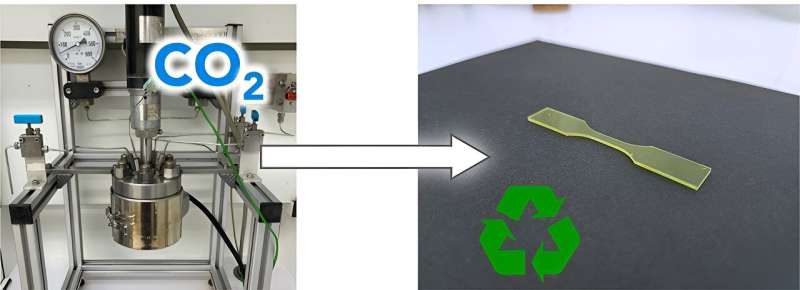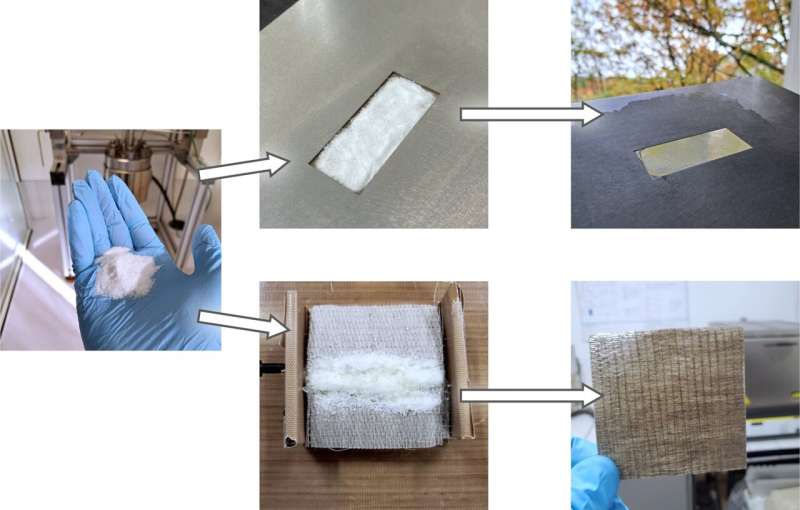This article has been reviewed according to Science X's editorial process and policies. Editors have highlighted the following attributes while ensuring the content's credibility:
fact-checked
peer-reviewed publication
trusted source
proofread
New technique can capture or reuse CO2 as a chemical source for the production of sustainable plastics

A team led by chemists at the University of Liège has developed a new polyurethane production technique using CO2 to create new types of easily recyclable plastics. The study, published in the Journal of the American Chemistry Society, could provide a solution for the development of truly sustainable plastics.
Commodity plastics have transformed global industry. Whether in construction, clothing, vehicles or food packaging, these plastics are everywhere in our daily lives, so much so that their global use has been estimated at around 460 million tons in 2019.
"This number is staggering, but not surprising, because plastics, also known as synthetic polymers, have met a large success thanks to their irreplaceable characteristics: they are light, cheap and incredibly versatile," explains Christophe Detrembleur, chemist at the Center for Education and Research on Macromolecules (CERM) of the University of Liège. "However, the fact that they are difficult to recycle, or even impossible to recycle in the case of thermosets, has serious consequences."
This impossibility of recycling not only leads to the depletion of the fossil resources used to manufacture them, but also to their very long-term accumulation in nature and the oceans. It is therefore imperative for our society to quickly design and manufacture plastics that can be easily recycled at the end of their life.
In this context, a study led by researchers at the University of Liège and carried out in collaboration with the University of Mons and the University of the Basque Country, reports on a new technique for producing easily recyclable polyurethane plastics.
"The special feature of this approach is the use of carbon dioxide (CO2 )—a major emblematic waste of our society—as a raw material for the production of the building blocks, or monomers, needed to manufacture these new products," explains Thomas Habets, a doctoral student at CERM and first author of the article. "The structure of the monomers can be easily modified, making it possible to produce plastics with a wide range of properties, from highly malleable elastomers such as silicones to more rigid materials such as polystyrene."
These plastics have a chemical structure that resembles a three-dimensional network rather than long linear chains. This structure, which is generally associated with thermosets that are very difficult to recycle, makes them more resistant than plastics made from long molecular chains. The polyurethanes created here have new "dynamic" chemical bonds, which means that despite their thermoset structure, they can be reshaped by exchanges of chemical bonds under relatively mild reaction conditions.

The greatest advantage of this new technology lies in its ability to vary the range of properties accessible while offering multiple ways of recycling materials at their end-of-life. "These new plastics can be recycled in multiple ways, either by simply reshaping them by heating them, or by mixing different types of plastic to create hybrid materials with new properties, or by breaking them down into their constituent monomers, which is ideal for eliminating additives such as dyes or recycling composites," continues Habets.
With a view to the future industrialization of CO2 valorization, this study demonstrates that waste CO2 can be directly used as a chemical resource. "This is the first initial study using our new building blocks and plastics," states Christophe Detrembleur, "but it is quite remarkable to see that our materials can already reach properties similar to those of some conventional petro-sourced plastics."
This new technology is emerging as a potential solution for the development of sustainable plastics with a wide range of properties that can easily meet the needs of most of our everyday applications.
More information: Thomas Habets et al, Covalent Adaptable Networks through Dynamic N,S-Acetal Chemistry: Toward Recyclable CO2-Based Thermosets, Journal of the American Chemical Society (2023). DOI: 10.1021/jacs.3c10080
Journal information: Journal of the American Chemical Society
Provided by University de Liege





















